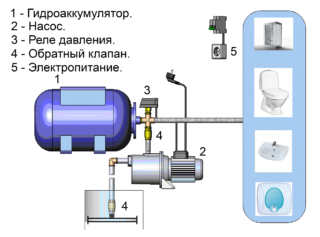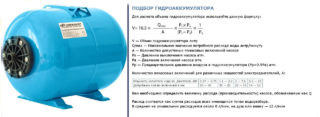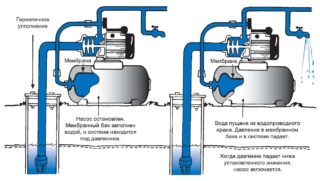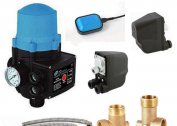Pressure installations with a hydraulic tank are used in autonomous and centralized water supply systems. The storage device is installed in a heated room or in a caisson near the well at a depth below the freezing point of the soil. The stability of the system depends on the correct choice of tank.
Purpose and design of the tank
 An item of equipment consists of a housing connecting a nipple, a polypropylene gasket and a rubber membrane. The latter is equipped with expansion tanks. Pump installations that provide water supply differ from heating analogues in the structure of the rubber diaphragm. Due to the pear-shaped form, the incoming liquid does not come into contact with the metal casing.
An item of equipment consists of a housing connecting a nipple, a polypropylene gasket and a rubber membrane. The latter is equipped with expansion tanks. Pump installations that provide water supply differ from heating analogues in the structure of the rubber diaphragm. Due to the pear-shaped form, the incoming liquid does not come into contact with the metal casing.
Hydraulic tank for a pumping station:
- maintains a constant pressure in a water supply system;
- reduces the frequency of turning on and off the supercharger;
- protects the unit from wear;
- protects against water hammer.
A pressure unit equipped with a hydraulic tank is more economical in the consumption of electric energy and water consumption.
Types and principle of work
A storage tank for the pumping station is used to withstand water shocks and keep a supply of water. The expansion analogue, in addition to these functions, additionally stabilizes the pressure in the water supply line. It is divided by a membrane partition into air and water compartments and works according to the following principle:
- By means of an electromechanical relay, the maximum permissible pressure indicator in the tank is set.
- During station operation, liquid is injected into the water compartment.
- The air in the second chamber is compressed, the pressure increases.
- Having reached the maximum permissible limit, the pump switches off.
- Equipment starts when pressure drops to a minimum.
When a small volume is consumed, water will flow into the mixer from the tank, and pumping equipment will not be started.
The expansion tank for each pump station model has design features. Issue devices with a built-in and interchangeable diaphragm. The latter options are preferable, because in the event of a rupture of the pear, it is quite easy to change it. The element is removed from the accumulator through a flange mount on the neck of the structure. During the repair work of the hydraulic tank of large internal volume, it will first be necessary to check whether there is any additional fastening of the diaphragm on the side opposite from the flange.
Criterias of choice
 When determining the required volume of the tank, the number of residents of the house and the number of water intakes that are capable of simultaneously consuming liquid from the tank are taken into account. For example, a 20-30 liter battery can meet the needs of a family of 3-4 people. Productivity of pumping equipment should be approximately two cubic meters per hour.
When determining the required volume of the tank, the number of residents of the house and the number of water intakes that are capable of simultaneously consuming liquid from the tank are taken into account. For example, a 20-30 liter battery can meet the needs of a family of 3-4 people. Productivity of pumping equipment should be approximately two cubic meters per hour.
The larger the volume of the tank and the less water consumption, the less often the automation starts pumping equipment. More than six starts per minute increase compressor wear by 20 percent. When launched more than ten times per minute, the degree of wear increases by 30–40 percent. Also, small tanks almost do not protect against water hammer.
Hydraulic tanks can be installed in two positions: horizontal or vertical. If the place allows, get the first option. With a shortage of space, a vertical device is chosen.
Pay attention to the material of manufacture. Steel tanks are more reliable since plastic is prone to deformation. The presence of a membrane protects the metal walls from corrosion.But steel structures are more difficult to mount due to the considerable mass.
Mounting Features
When installing, you need to consider the possibility of access to the accumulator. The device is connected to the water supply anywhere after the pump and the non-return valve. The device must be grounded.
Connection diagram of the unit to the pressure unit, depending on the pumping equipment:
| Pump type | Connection Procedure |
| Submersible, semi-submersible | Pump station - non-return valve - hydraulic tank - pressure sensor. |
| Submersible centrifugal and surface centrifugal | Pump station - non-return valve - hydraulic accumulator - second pump - pressure sensor. |
When installing a surface pump, a hydraulic accumulator is located close to it. If the flow of 20 liters of water per minute is sufficient, in the last scheme it is allowed to install both pressure devices of the submersible vibration type. The design will come out much cheaper.
The connection of the hydraulic accumulator to the downhole pumping equipment is carried out in compliance with safety regulations with the power supply turned off to prevent accidental start-up.



